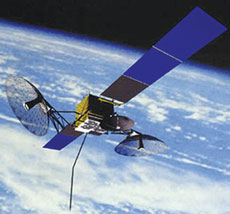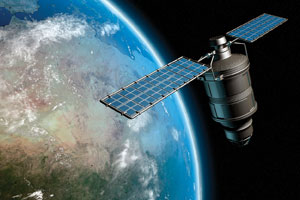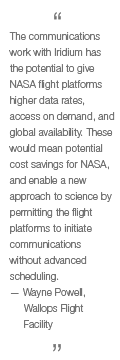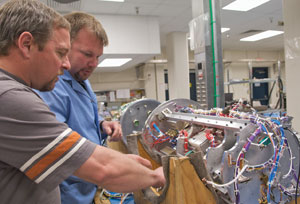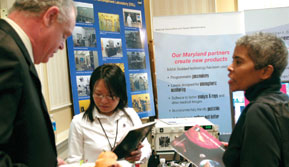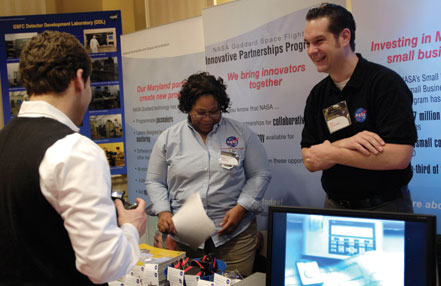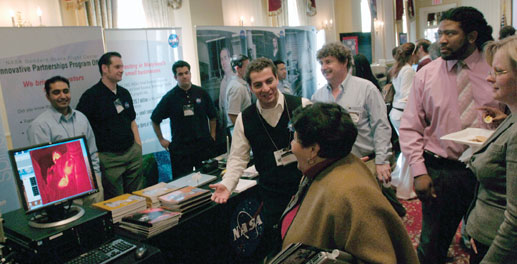|
||||||||||||||||||||||||||||||||||||||||||||||||||||||
| volume 6, number 2: SPRING 2008 |
|
|||||||||||||||||||||||||||||||||||||||||||||||||||||
|
[Links followed by * open new browser windows.] |
||||||||||||||||||||||||||||||||||||||||||||||||||||||
|
Wallops Offers a One-Stop Shop for Testing and Space-Qualifying Technologies
As the principal facility for NASA’s suborbital research programs, Wallops Flight Facility* offers both non-NASA organizations and other NASA centers unique opportunities for development and testing of new and existing technologies to prepare them for spaceflight or suborbital applications. Access to a wide range of vehicles, extensive payload and testing expertise, and end-to-end mission implementation capabilities, combined with the test range, make Wallops a true one-stop shop for technology maturation.
Take advantage of multiple craft for instrument testing and experimentation As NASA’s premier test-flight facility, Wallops offers the capability to test technologies and instruments on a wide range of craft, including sounding rockets, balloons (launched from Wallops as well as remote locations), manned aircraft, and unmanned aerial systems (UAS). With one UAS runway in use, Wallops currently is building a new control center, and proposals are being considered to build a second UAS runway—enabling Wallops to accommodate even more individual flights or tandem experiments.
Since each type of flight platform offers unique advantages, having a range of options available on site is a significant advantage for innovation, says Wallops technologist Wayne Powell. For example, a ground-breaking collaboration between NASA and the National Oceanic and Atmospheric Administration (NOAA)* resulted in the first unmanned flight into a hurricane (Hurricane Noel) in November 2007. A UAS launched from Wallops flew into the eye wall of the hurricane, controlled remotely by scientists who made detailed observations in areas that would have been too dangerous for manned aircraft. While this was a rather advanced example of flight-testing capabilities, other projects that are in initial testing stages may benefit from exposure to balloon or sounding rocket flight environments, said Powell. “And then some instruments will need to be tested on a combination of flight platforms in order to fly to different regions and conditions to evaluate how the instruments respond. And since we have all of these craft available, Wallops can provide exposure to most spaceflight environments.” Ultimately, said Powell, this translates into innovation and testing being conducted in less time and at a lower cost. Several Small Business Innovation Research (SBIR) awards being carried out at Wallops are taking advantage of the opportunity to increase an instrument’s technology readiness level (TRL) via experimentation on multiple craft. For example, Stratton Park Engineering Company (SPEC)* and Anasphere* will take advantage of both UAS and balloons at Wallops to test miniaturized cloud sensors in different conditions. Read more about these SBIR awards. Experience the freedom of restricted airspace
“One of the unique advantages of Wallops’ location is that we have access to a corridor of restricted airspace from the Wallops runways to the ocean and, therefore, lower flight restrictions,” says Powell. In fact, Wallops is one of the few U.S. flight facilities offering this capability. The safety advantage of restricted airspace is that only authorized participants in the exercise are permitted entry. And unlike Wallops’ restricted airspace, there are many limitations when flying in the national airspace (over the continental U.S.), including scheduling, duration, and other requirements. “When you’re flying an experiment in national airspace, the FAA [Federal Aviation Administration] requires you to have a chase plane,” explains Powell. “This makes it infeasible for UAS missions because the whole point is to test without a manned aircraft.” It also adds time and research dollars to the mix because another aircraft and more personnel are required. In contrast, Wallops’ restricted airspace is free of these concerns because it is restricted to government use—so commercial aircraft schedules need not be a factor in planning. This unique advantage enables relatively unhindered experimentation of technologies and testing of the unique environmental and atmospheric properties over the ocean. Work with teams small in size, but big in expertise
Another advantage of the Wallops environment is the team philosophy. “We tend to work in small teams, in close partnership with any contractors and outside organizations, with lots of support for ongoing innovation,” explains Barton Bull, Chief Engineer of the Wallops Launch Range. “There’s a lot of close work between the engineers and the scientists. We really roll our sleeves up and get our hands dirty.” The small-team, hands-on philosophy at Wallops results in concepting, building, and implementing operations that are very agile and flexible to respond to changing needs and technological requirements. Communication tends to be conducted in real time, face-to-face or over the phone, rather than pushing documents back and forth—making teams more responsive and maintaining the integrity of schedules. But just because the teams are small, they are certainly not lacking in skill set. “The people here are accustomed to wearing multiple hats. We have a broad range of knowledge and ability to get the job done and respond to a variety of needs,” says Powell. Indeed, with more than 50 years’ experience with suborbital projects, the staff at Wallops provides expertise in all engineering disciplines, flight structures, flight and ground instrumentation, project management, mobile campaigns, and much more. The staff includes scientists, pilots, project managers, engineers, photographers, and safety specialists—as well as technicians of multiple trades. “When you work on a small team, you’re allowed—and even required—to understand more about what the people around you are doing, and you’re encouraged to step up to new skills and develop further expertise,” says Bull. “This breadth of knowledge and skills certainly adds to the value and responsiveness of our work.” Whether operating on-site instrumentation or traveling the world with Wallops’ unique mobile facilities, the researchers, contractors, and partners are offered full support. “Launches conducted at remote sites are common, and the remote teams support each other just as they would here at Wallops,” says Bull. “The team is given the authority to solve problems as they arise, find innovative solutions, and feel satisfied that they’ve contributed to getting the job done.”
Be assured of end-to-end implementation for lower costs and faster turnaround With on-site facilities and labs for safety, control, calibration, fabrication, and launch, Wallops offers a one-stop shop to meet the needs of nearly any mission, end-to-end, with reliability. This self-sufficient nature makes Wallops a very cost-effective flight facility capable of turning around projects with tight schedules, says Powell. “For outside organizations and other NASA centers, one of the most attractive aspects of the work we do here is time frame. The duration of time between concept and implementation is very short. Satellite missions might take 10 years to collect data from the time of concept definition. Here, concept to fruition is sometimes just a few months—so you get to see your ideas and test results come together quickly.” Powell credits the short time frames and cost savings not only to the stocked library of standard components from which extremely flexible flight-support systems are configured but also to the tight-knit Wallops organization. “We have a safety group that works side-by-side with the launch teams. If a safety issue is recognized, it is addressed in real time rather than waiting until the next review.” Powell says having the in-house capabilities can save both NASA and its partners research dollars and time. “We can simply do it faster and for less because we can take care of everything in house,” says Powell. “We have a machine shop to address and correct mechanical problems. We have calibration labs to take measurements. Without these facilities, we’d have to send things back to the factory when problems arise. It’s because we have these end-to-end, in-house capabilities that we are able to achieve these short-duration missions with safety, reliability, and success.” For more information The Wallops Web site* offers a wealth of information about its location, facilities, capabilities, and much more.
|
||||||||||||||||||||||||||||||||||||||||||||||||||||||
James "Barton" Bull As Chief Engineer for the Wallops Launch Range, Barton Bull wears many hats: in the lab, on the launch pad, and at the negotiating table. In this interview, Bull shares a close look at his work supporting many facets of the missions at Wallops, and the exciting work being done at the test range. As Chief Engineer for the Launch Range, you must stay quite busy. Can you give readers some background about what your role entails? I wear some distinctly different hats. As Chief Engineer of the research range, I’m responsible for engineering upgrades to equipment, procuring new equipment, trouble-shooting mission support issues. I help arrange engineering support for missions, and I conduct design reviews and make sure payload requirements are satisfied. Our goal here is to be a “test range for test ranges.” That is, to be a flexible proving ground for new launch technologies that can later be deployed on larger, less flexible ranges. My second hat is worn for leading efforts for the Advanced Range Technologies Initiative [ARTI]. Here at Wallops, we support a broad range of missions. The research range is responsible for successfully launching orbital and suborbital rockets, UAS [unmanned aircraft systems] and aircraft—so it’s a complex operation requiring integration, testing, data displays, command transmitters, end-to-end facilities. We have a constant drive to improve and build new systems. My job is to support innovators in their efforts. We work in small teams driven by their own initiative. And I support the work of these teams by nurturing contacts with other NASA centers and outside organizations. I am constantly on the prowl for funding. I act as a liaison between AETD contractors and Wallops, and I help offload the administration, configuration, control, reporting, and other functions that would otherwise drain a small team. We try to keep the designers busy with the designing instead of all these extraneous things. I help provide the machinery to keep these teams going.
It does keep me busy and it’s to support the people really doing the innovation. I go to a lot of range safety group meetings to brief them on what we’re doing, show them design decisions we’re making, and get their input. I spend a lot of time with Air Force* groups interested in operational readiness and responsiveness, looking for opportunities where we can work together, and trying to understand their needs that might be fulfilled with our systems. I work with contractors to make sure we have the optimal mix of people on projects. All of this is aimed at letting the designers do their design work. If I can respond to questions and keep them up to date then it saves them from having to stop the important work they are doing. It sounds like you find the work rewarding. What excites you most about the work happening at Wallops? My work with ARTI is especially rewarding because we get tremendously good support from the range and mission management offices. They give me a lot of latitude to use the talented people here as I see fit—so we’re able to be flexible in assigning people to teams they are excited about, or even have people work with more than one group at a time. We are constantly working on new innovations to support the orbital and suborbital missions here, which is very exciting to be a part of. For example, we’re looking into new and integrated surveillance systems—range displays to show where a rocket or UAS is traveling, its health, and its status. We’re also looking at many different functions that may be handled by onboard navigation systems to make flight determination more autonomous. This would result in a range free of the expense and constraints of the present infrastructure. The mission planning lab [MPL] is an important part of the effort. The Autonomous Flight Safety System [AFSS] (which we’re working on with the Air Force and DARPA*) and the Low Cost Tracking and Data Relay Satellite System [TDRSS] Transceiver* will also be a part of this tool. So it’s very rewarding to work on these types of initiatives that are trying to leverage space-based assets to make our operations less costly, more flexible, and safer. Ultimately, we want to be able to launch from different sites and track more than one missile at a time and to ready missions for flight even faster than we do now. Wallops is being recognized throughout the launch community as a leader in these efforts.
Yes, we’re really excited about the TEI funding. We initially received funding from DARPA for the initiative, and then Goddard’s IPP Office also encouraged us to apply for HQ’s TEI funding. The combined funding will make it possible for us to fly our next AFSS test on a sounding rocket here at Wallops (tentatively planned for summer 2008) rather than having to piggyback on another mission’s schedule to test it out. And once testing is complete, what will AFSS help NASA achieve? Why is it ultimately such an important initiative for Wallops? Well, it’s a big step forward from where we are now with flight termination, which is currently done the same way it was 50 years ago. We track the rocket with radar and process telemetry. If there's a problem, a person pushes a button, sending a signal from a powerful transmitter to the rocket. All of these systems have to be extremely reliable, redundant, manned, and maintained—even between missions. Obviously, this is very expensive. With AFSS, we won’t need these redundant telemetry and command systems. The modern flight technology that’s being developed will autonomously know where the rocket is, whether it has enough energy to make its intended orbit, how long it would take to get to a protected area if there is a problem, and so on. There simply is no other technology—that we know of—that holds as much promise for lowering the cost of safe access to space as AFSS. So AFSS is part of a larger flight termination system? Yes, AFSS will be part of the larger space-based range. The elements of this initiative are in various stages of development, and AFSS will require the most time and the most funding—which is another reason why the TEI funding was so crucial. Also, we operate as a safety function, plain and simple. We have requirements for .999 reliability. As you might imagine, this is very difficult to achieve. This will be ARTI’s longest initiative, so we really need to have our ducks in a row.
How did you get to where you are now with the initiative? One of the initial steps was the building of a GPS/IMU simulation facility and development of range-safety decision algorithms. The AFSS effort includes NASA’s Low-Cost TDRSS Transceiver [LCT2], which we needed so we wouldn’t be limited to line-of-sight on our sounding rockets. A small team from Wallops launched it on an Air Force rocket (the Cosmic Mission), and it was so successful that we were deluged for a while. We started producing them for the Missile Defense Agency, for NASA, and for other areas of the military. We originally thought it would just be a TDRSS transceiver to work with NASA’s TDRSS satellite at a given wattage—but it turned out that the transmitter found a niche for itself with many of these other groups who were excited about the technology. So we built six of them, but then it was time for someone else to handle the manufacturing. So this is where technology transfer played a role? Yes, the IPP Office helped us transfer the technology to an outside company to handle manufacturing: They handle the production of the transmitter, and we can focus our efforts on engineering the transceiver work. So we’ve discovered the value of tech transfer here at Wallops. In fact, several of the technologies that go into AFSS will most likely be ultimately manufactured outside NASA—so those will involve tech transfer agreements of some kind. It’s great that the IPP Office has the infrastructure to handle these agreements for us—because Wallops simply is not a manufacturing group, and we don’t want to be. We want to focus on what we’re good at. We’re glad the IPP Office can put the partnerships in place to make that possible. Have you found collaboration to be key to this initiative? Oh, yes. All of our work is collaborative in nature. With AFSS, we’re partnering with Kennedy*, the Air Force, and DARPA. And the work the IPP Office did to help us get TEI funding—that was a collaboration in itself. And what we’re doing with that award lets us augment money that we got from Kennedy, DARPA, and the Wallops range itself. This is very much a collaborative effort as far as the funding is concerned. Are you working on any other collaborative initiatives? There always seems to be collaboration happening in one form or another at Wallops. That’s our very nature. The facilities are test beds for other companies and other NASA centers to space-qualify their technologies, so we’re involved with those collaborations on an ongoing basis. As for some of the larger initiatives, like the autonomous space-based navigation, we’re collaborating with the Air Force to port over a new modulation technique they’ve developed for LCT2. They collaborated with JPL* on the technology and are now coming to Wallops for our hardware and facilities. Along those lines, the Missile Defense Agency will soon be launching a rocket at Wallops that will use the LCT2 box, programmed to increase the frequency to a certain level and sending output to a commercial power amplifier. We’ll be collaborating on that effort to test higher data rates for the LCT2. All of these smaller collaborative efforts are making up the picture of a very exciting larger effort. What do you think is the benefit of these collaborative efforts? We go all over the world launching payloads, and the needs of these other organizations are often very much in line with ours. We’re all in the same business and using the taxpayers’ dollars. So if we can work together to make it cheaper to launch a rocket, everyone wins. Also, the expertise and facilities we provide our partners put Wallops in a state-of-the-art position. We also help save taxpayer dollars by leveraging the customer’s paid projects. The know-how we gain through these projects can then be transferred to our own NASA missions. So in the end, the customer benefits, the taxpayer benefits, and NASA benefits. Clearly, this is advantageous.
|
||||||||||||||||||||||||||||||||||||||||||||||||||||||
|
|
Wallops Flight Facility announces several recently funded partnerships and offers facilities for use by potential partners. GSFC Partners with Iridium to Benefit From Iridium’s “NEXT”-Generation Communication Capabilities
Through the agreement, NASA will be able to influence the NEXT system capabilities to meet NASA mission needs. Researchers expect that the lower costs and continuous access will enable many more small experiments as well as two-way emergency communication services or contingency voice services for manned exploration missions. The results also are expected to benefit space and Earth science missions including sounding rockets, unmanned aerial systems (UAS), and balloons.
Through a Phase 2 Small Business Innovation Research (SBIR) contract funded by NASA, researchers at Stratton Park Engineering Company (SPEC)* have developed prototypes of miniaturized cloud sensors for use on small, unmanned aerial systems (UAS) and balloons at Wallops Flight Facility. Pending testing of the sensors, SPEC expects the technology to provide critical in situ cloud data that will help environmental scientists better understand the impact that clouds have on climate. The in situ cloud data can be compared with data from ground-based and satellite-borne remote sensors, thereby improving the retrievals that the remote sensors use to characterize clouds. In turn, improving satellite retrievals of cloud properties is critical for refining and validating numerical models that predict global climate change. SBIR Advances Our Understanding of Clouds and the Carbon Cycle
Goddard’s IPP Office is also pleased to announce the signing of several new agreements.
|
|||||||||||||||||||||||||||||||||||||||||||||||||||||
|
Public Gains Insight Into Goddard Technology and Value at Maryland Space Day Legislators, members of state departments, media, school groups, and business representatives were among the attendees of Maryland Space Day, held February 21 at the Presidential Conference Center in Annapolis, MD. Sponsored by Goddard’s Government and Community Relations Office, the event featured displays of Goddard missions along with innovators on hand to answer questions. Notable presentations included an appearance by Nobel Laureate and physicist Dr. John Mather. Educational materials as well as models of the Hubble* and James Webb Space Telescopes* were also available. The event also offered an ideal opportunity to highlight the ways in which technology transfer and partnerships have benefited the state of Maryland and the Maryland economy, said IPP Office Chief Nona Cheeks. “The work of the Innovative Partnerships Program at Goddard helps transfer technologies out of the space program into businesses in Maryland and across the U.S., finding new uses for the technologies here on Earth—and benefiting their business and the state economies as a whole,” said Cheeks. “We also look to a growing number of technology-based organizations within the state to form partnerships that will help meet NASA needs. Working synergistically with businesses in the state of Maryland is a win-win opportunity.”
The IPP Office presented examples of significant technology transfer partnerships in Maryland that have resulted in advanced materials for instruments and electronics such as medical imaging devices, intelligent highway systems, and others. And the day concluded with a public signing of a very promising new agreement between Goddard and Northrop Grumman’s* Maryland-based Electronics Systems Sector, the aim of which is to develop advanced remote sensing capabilities to better understand the history and habitability of Mars and other planets, as well as the role of carbon cycles on Earth. (Editor’s Note: The Northrop Grumman agreement will be covered in detail in the Summer 2008 issue of Goddard Tech Transfer News.)
Goddard’s IPP Office also attended several other events during Q2 2008:
|
||||||||||||||||||||||||||||||||||||||||||||||||||||||
|
TEI Funding Awarded to Goddard/Wallops Projects for 2008
NASA Headquarters’ Office of the Chief Engineer’s Technical Excellence Initiative (TEI) provides funding for research and development projects that offer solutions to technical challenges affecting multiple Mission Directorates. Goddard submitted proposals for the two funded projects described below. The IPP Office coordinated Goddard’s activity for the TEI Call. The IPP Office congratulates the winners of TEI funding: Made possible through TEI and Defense Advanced Research Projects Agency (DARPA)* funding, a collaborative arrangement between NASA, the Air Force* , and DARPA will enable Wallops Flight Facility and their partners at Kennedy Space Center* to help hasten the certification process for NASA’s Autonomous Flight Safety System (AFSS). A nontraditional Flight Termination System, AFSS provides trajectory information for flight-termination decisions by incorporating rule-based algorithms coded onto redundant flight processors. The system augments or replaces the functions of traditional ground-based tracking and safety systems and provides for range safety beyond the radar horizon, in the presence of Radio Frequency Interference and in situations requiring minimal response time. The system represents leaps forward in traditional flight safety. This NASA and DARPA-sponsored effort will enable testing of the merger of AFSS with NASA’s Low-Cost TDRSS Transceiver (LCT2)*, which provides tracking data and other telemetry, including that needed for AFSS verification. The proof-of-concept will be flown on a sounding rocket test flight from Wallops in 2008, led by principal investigator Barton Bull. Integrated Space Weather Analysis System From robotic missions to human exploration, space weather has an impact on nearly all NASA endeavors. Principal investigators Michael Hesse (Code 674) and Marlo Maddox (Code 587) have received TEI funding to develop an Integrated Space Weather Analysis System to help better understand and predict space weather conditions as they relate to NASA mission operations. The proposed turnkey, Web-based dissemination system for NASA-relevant space weather information will combine forecasts based on the most advanced space weather models with concurrent space environment information. Customer configurable and highly adaptable, the proposed system is expected to enable retrieval of environmental data and model outputs from a large and evolving list of sources, and then sort and characterize the nature of the data. The output can then be processed into “mission decision supporting” outputs in response to specific user queries and displayed in user-friendly formats. NASA Inventions and Contributions Board Awards The following awards were issued by ICB during the second quarter of FY08. Tech Briefs Awards
Software Release Awards
Space Act Awards
|
||||||||||||||||||||||||||||||||||||||||||||||||||||||
Sign Up Now for Tech Transfer Training!
The IPP Office’s successful “Introduction to NASA Goddard Technology Transfer” is an overview course designed to familiarize NASA civil servants and contractors with policies and procedures related to technology transfer. Special emphasis on Goddard-specific practices provides participants with the knowledge and tools they need to work with the IPP Office on many different technology transfer and partnership activities. Why attend technology transfer training? Technology transfer training is vital to helping you understand key concepts that can benefit both you and Goddard. In the training, you will learn:
2008 Tech Transfer Overview Course dates have been scheduled—giving you plenty of time to sign up well in advance. You need attend only one of the scheduled dates. Tech Transfer Training: June 26 September 18 December 2 location: The course is held in Goddard Building 1, Room E100D to register: Civil servants can register online*. Contractors can register by contacting Dale Hithon (301-286-2691), who can also provide further information about the training.
|
||||||||||||||||||||||||||||||||||||||||||||||||||||||
|
||||||||||||||||||||||||||||||||||||||||||||||||||||||
|
Innovators: Remember to report your new technologies through the online eNTRe system. eNTRe makes it convenient to file your New Technology Reports (NTRs) quickly, easily, and securely. Filing your NTRs enables the Innovative Partnerships Program (IPP) Office to support you by:
|
||||||||||||||||||||||||||||||||||||||||||||||||||||||
|
Chief: Nona Cheeks Goddard Tech Transfer News is the quarterly magazine of the Innovative Partnerships Program Office (Code 504) at NASA Goddard Space Flight Center in Greenbelt, Maryland. This magazine seeks to inform and educate civil servant and contractor personnel at Goddard*, as well as at Wallops Flight Facility* and the Independent Verification and Validation (IV&V) Facility*, about actively participating in achieving NASA’s technology transfer goals:
Please send suggestions or feedback about Goddard Tech Transfer News to the editor. |
||||||||||||||||||||||||||||||||||||||||||||||||||||||
|
||||||||||||||||||||||||||||||||||||||||||||||||||||||


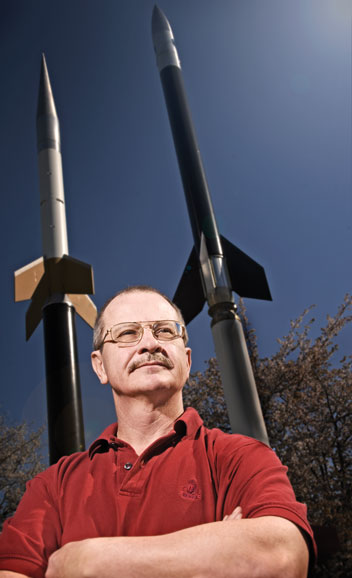

sm.jpg) Nona Cheeks
Nona Cheeks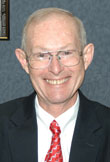 Dr. John Campbell
Dr. John Campbell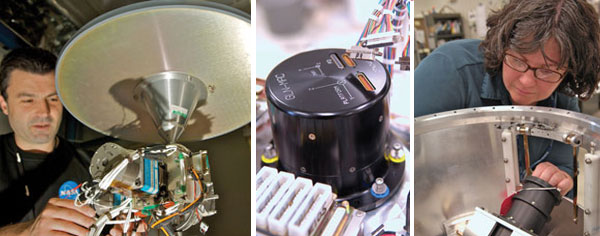

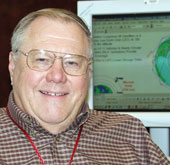
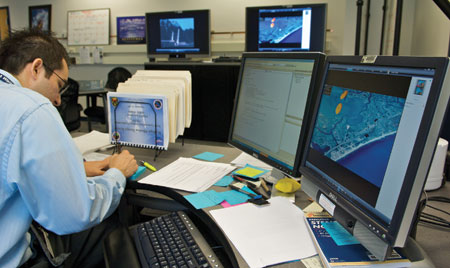
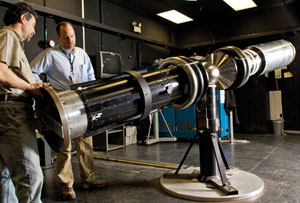

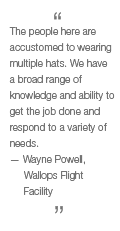

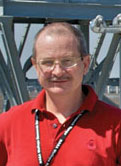
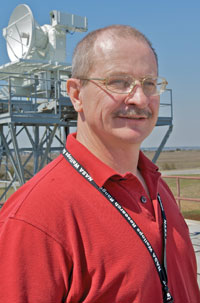
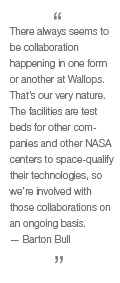 You mentioned the AFSS work with DARPA. You were recently awarded Technology Excellence Initiative funding for this work, correct?
You mentioned the AFSS work with DARPA. You were recently awarded Technology Excellence Initiative funding for this work, correct?